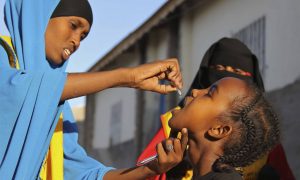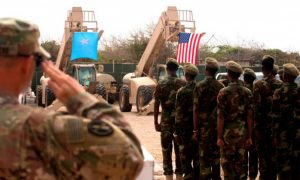
Mogadishu 17 OCTOBER 2017 – When Somalia’s deadliest truck bomb exploded on Saturday, Abdi Ali Ibrahim raced to the smoking crater just meters from where his beloved sister Asha had a small business selling fuel.
The truck had detonated next to a fuel tanker causing a huge fireball and the road was strewn with body parts. Hopeful that Asha, a pregnant mother-of-two, may have been injured and taken away by ambulance, Ibrahim embarked on a frantic round of Mogadishu’s hospitals, starting with the biggest, Madina.
“I found many dead bodies, injured ones, body parts and burned bodies that were horribly shrunken. She was not there,” he told Reuters as he sat hunched on a bench.
For two days Ibrahim clung to the hope that 44-year-old Asha had somehow survived the twin bombings that killed more than 300 people, the worst such attack in Somalia’s history.
The bombings were similar to others claimed by al-Qaeda-linked al-Shabaab insurgents although the militants have yet to claim Saturday’s attacks. Experts say the target may have been nearby government buildings, but the bomb went off too early.
Rushing from hospital to hospital, Ibrahim was nauseated by the piles of burned flesh, but also tormented by the slim possibility his sister and her unborn baby might have survived and be in pain somewhere needing his help.
Finally, Ibrahim returned to the scene where Asha sold fuel.
“Just three meters away from where she sat, I saw a dark hole blown by the truck bomb. I could see sacks laid by the road upon which police placed organs, heads, limbs,” Ibrahim said.
“I saw her hand on a stone under a tree. It was her hand and it had the ring on her finger.”
Ibrahim took the hand to his elderly mother. He said she cried so hard that at first her words were inaudible to the crowd of relatives pressing around her.
“She touched the hand three times and said, ‘This is the hand of my daughter, I am sure. This is the ring on her finger … go and bury her’.”
MASS BURIALS
As the scale of the attack became clear, President Mohamed Abdullahi Farmaajo ordered three days of national mourning, doctors begged for blood donations, and the city’s overstretched ambulance workers who had toiled to save the injured found time to begin ferrying the dead to the morgue.
Mass burials of unidentifiable bodies began, the blackened corpses wrapped in white sheets. Perhaps one of them was Asha. That gave Ibrahim and Asha’s children from her first marriage, a 21-year-old son and 23-year-old daughter, a new problem. Could they conduct a funeral service for a hand if they could not find a body?
“I asked many clerics how I should bury a hand,” Ibrahim said. “Some said funeral prayers must be conducted over the hand before burial. Others rejected my idea and said no funeral prayer could be given for a body part.”
“Finally I washed the hand, wrapped it in a piece of white shroud and buried it in a grave.”
The dilemma is becoming more and more common. Al-Shabaab is using bigger and bigger bombs.
In 2016, 723 Somalis were killed in 395 bomb attacks, according to Nairobi-based think-tank Sahan Research, up from 193 deaths in 265 attacks in 2015. This year will probably be another grim record in the Horn of Africa nation, which has been riven by civil war since 1991.
According to think-tank Sahan, 40 percent of those killed last year and more than half of the injured were civilians.
The Islamist insurgency that began in 2007 has been steadily losing ground since it was driven out of the capital Mogadishu in 2011 but its ability to mount devastating attacks remains.
Ibrahim said he was distraught when he first saw Asha’s hand but is glad now that he found it.
“I am satisfied because I know my sister has died,” he said. “There are many people who have not even found a single piece of their missing loved ones.”
Source: Reuters
_____________________________________________________________________________________Xafiiska Wararka Qaranimo Online | Mogadishu, Somalia
_____________________________________________________________________________________Advertisement
_____________________________________________________________________________________







